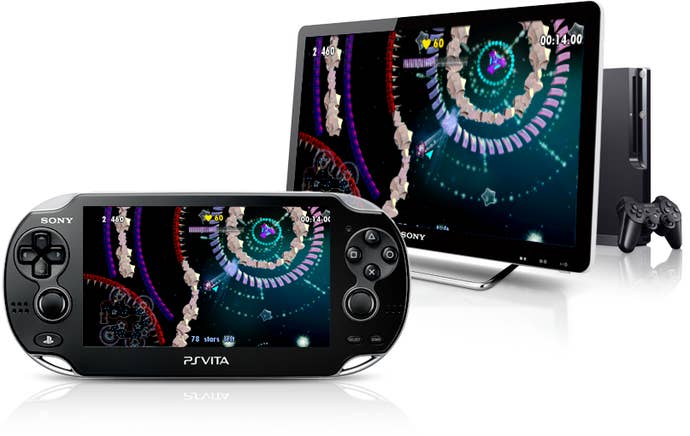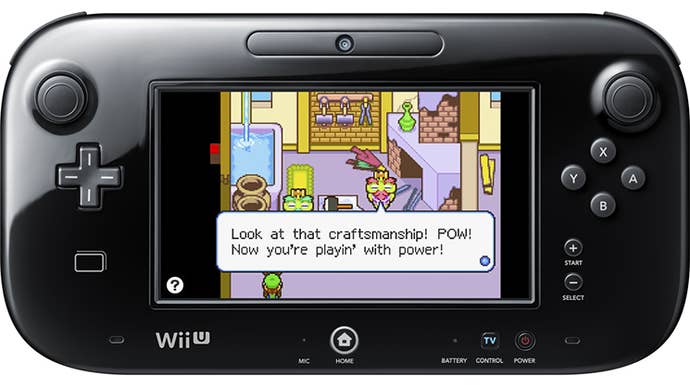Game Boy Advance Bodes Well for Virtual Console, But....
We'd like to think Nintendo's latest classic reissues are a sign of great things to come, but history tells us not to get our hopes up.
This article first appeared on USgamer, a partner publication of VG247. Some content, such as this article, has been migrated to VG247 for posterity after USgamer's closure - but it has not been edited or further vetted by the VG247 team.
Picking on Nintendo's Virtual Console has long been a favorite pastime of mine; back in the olden days of Retronauts, it was a weekly habit. These days, I tend not to complain as much, because no one wants to hear the same gripes eight years running.
Well, some people do, or else political talk radio hosts would be out of a job. But let's not sink to that level. Some dignity is in order, here... though sometimes I wonder if anyone ever told that to the people responsible for Nintendo's Virtual Console. As time goes by, the service has aggressively failed to better itself, suffering several setbacks for each improvement it offers. I remember once when I lamented the fact that Urban Champion was one of five games released in a single week for Wii Virtual Console – boo hoo, all these gems and one dud – whereas these days fans would kill to have any five games released all at once. We didnt know how spoiled we were in the early days, but I suppose you really don't love what you've got until it's gone.
And speaking of clichés, I only hurt Virtual Console because I love it. Or rather, I love the idea of it. I wholly agree with the fundamental premise that video games have value, even when they're old. I am willing to pay money for good classic games rendered in a playable format on current systems. I think Virtual Console is a tough sell for Nintendo, though, because so many other publishers have been eager to devalue classic games with sloppy ports, flimsy compilations, and other missteps. While my ideal version of Virtual Console would be a paid monthly service that allows you to download selections from a massive library of titles (basically PlayStation Plus meets Netflix on a vast scale), the individually curated selections approach has merit, too.

It could stand refinement, though. Besides the paltry selection of titles available for 3DS and natively for Wii U, Virtual Console also suffers from substandard quality on the technical side of things, too. Wii Virtual Console actually got it right for the most part: The emulation of games was rock-solid, if feature-poor, and they looked practically perfect thanks to fact that the Wii actually changed its output to match the native resolution of the console it was emulating. While everyone else in the industry was puffing their chests out about true 720p and 1080p (which even on the newest consoles remains some Dulcinea-like fantasy), Nintendo was churning out games at 224p, and it was amazing.
Virtual Console on 3DS and Wii adds more bells and whistles – save states and off-screen play – but inexplicably forsakes things Nintendo got right on Wii, like true pixel resolution options. 3DS Virtual Console can run Game Boy games at native resolution (160x144), but inexplicably not NES games, so NES games are stretched ever-so-slightly from 256x224 to 274x240 with no native option available. Meanwhile, NES and SNES games alike look blurry and washed-out on the Wii U Game Pad. Fidelity used to be Virtual Console's saving grace, but these days it offers neither volume nor quality – which is especially baffling given Wii U's desperate need for any content whatsoever.
But! Yesterday saw Nintendo rounding a corner of sorts with Virtual Console. Game Boy Advance software made its debut on Wii U, and it's off to a fantastic start. America received three top-calibre games – Advance Wars, Mario & Luigi: Superstar Saga, and the better-than-some-people-are-willing-to-admit Metroid Fusion – as the first wave of nearly a dozen GBA titles that'll be hitting Wii U this month.

Granted, this isn't without its drawbacks; the idea of publishing GBA software on a console but not a portable system feels weirdly backward. After all, 3DS "Ambassadors" already have access to several of these games on their portable systems, so why not continue that trend? Evidently the disconnect there stems from the 3DS simply not being powerful enough to render GBA games properly; the Ambassador titles use the GBA hardware mode included in the 3DS's built-in DS hardware (confusing, right?) and lock out all the 3DS's fundamental features by literally reverting the system to a GBA in another system's case. That's why the Ambassador GBA games can't sleep and can't Street Pass; the 3DS basically becomes a GBA, and Nintendo evidently can't figure out a way to make that mode play nice with 3DS's advanced features and understandably doesn't want to publish a bunch of games that cripple its fancy modern handheld. The Wii U, on the other hand, can easily emulate a 13-year-old ARM-based system. So Wii U gets the GBA Virtual Console, even if it would seem to make more sense to have those games on 3DS.
To make up for this irritating wrinkle, Nintendo has done its audience a solid by hiring classic emulation gods M2 to do the heavy lifting for its GBA titles. After years of being generally amazing behind the scenes, M2 has recently enjoyed a bit of fame thanks to their stupendous work on the 3DS Sega Ages collection, lavishing games like Sonic the Hedgehog with reverent affection. Historically, outside of programming Konami's ReBirth games for WiiWare, M2 has focused on Sega with its retro work: They programmed the Game Gear emulator for 3DS and handled Sega's consoles for Wii Virtual Console. They also produced several Japan-only PlayStation 2 Sega Ages collections (including Monster World, Gunstar Heroes, and Fantasy Zone) that are probably the closest thing video games will ever see to Criterion Collection treatment of classics. To my knowledge, the GBA Virtual Console marks their first foray into replicating a Nintendo console – and having taken these first three titles for a spin, I hope it's not their last.
Compared to their previous emulation work, the GBA Virtual Console does seem somewhat barebones. You won't see the funky visual wrappers and screen emulation of Game Gear VC, for example; where M2's Game Gear and Sega Ages releases allow you to simulate the ghosting and blur of their original hardware's actual screen or replicate the physical action of specialty hardware cabinets, GBA games don't allow you toggle between, say, dim-and-dark GBA classic and side-lit GBA SP modes – unsurprisingly, Nintendo seems less concerned with reproducing an authentic experience and more determined to provide a rose-tinted revisiting of this material. Also missing is the interesting supplemental material that their PS2 collections incorporated – so no international versions of games, or archival footage of things like the weird Game Boy Color prototype of Metroid Fusion.
There's also no opportunity to dicker with the inner workings of the games. Unlike the 3DS Sega Ages titles, you're not allowed to create modern control setups. Imagine if you could revamp Metroid Fusion to control like Super Metroid, taking advantage of the fact that the Wii U has far more buttons than the GBA did. But no.
Even if the GBA Virtual Console does incorporate a dearth of bonus options, the features it does include are the ones that really matter. Off-screen play on the Game Pad reproduces the games' visuals with far more clarity and sharpness than Nintendo's internal developers managed with NES and Super NES software. You can toggle the video that's output to television between smoothed or sharp, scaled and stretched or "true" resolution. And, at long last, you can finally customize the button configuration on a Nintendo console's VC adaptation so that the Wii U's A and B buttons don't have to map to the target console's A and B buttons. It's a welcome modification, since only Super NES used the current systems' diamond configuration for their face buttons, creating a small but profound difference in play ergonomics. M2 even went the extra mile with the manuals, providing crisp scans of the games' original full-color booklets rather than throwing together quick play summaries. And of course the usual save state features return.

All in all, these GBA games mark the first time Virtual Console has treated a classic Nintendo system as if someone actually loved playing it and wants to pay it forward to a new generation. The gulf in quality between Wii U's GBA game emulation and its treatment of NES games is frankly embarrassing. It's probably too late to salvage the NES or Super NES Virtual Console, but assuming we ever see other emulated consoles make their way to Wii U (I mean, where are the N64 games?), we can only hope Nintendo will take its cues from M2's work on these GBA titles.
As for the long-term prospects of GBA on Virtual Console... well, I'm keeping my hopes in check. Nintendo has demonstrated a remarkable ability to disappoint with new systems appearing on Virtual Console. Remember when Virtual Console Arcade was a central talking point of Satoru Iwata's Game Developers Conference keynote... after which we saw only a handful of arcade titles actually make their way to VC, none of which included Nintendo's own seminal arcade creations? Remember that brief period when they released Game Gear software on 3DS, a venture that fizzled out after a paltry 16 titles? I honestly don't expect to see many GBA releases after this month, though I wouldn't mind being proven wrong.

Of course, Nintendo's not talking about their plans, their decisions, their ambitions, or pretty much anything at all, really. Every interview request I've made to talk to someone about the workings of Virtual Console over the years has been taken out behind the woodshed and summarily shot (including a request to discuss these GBA releases). In recent years, we could at least look forward to an Iwata Asks in which some information, however scrupulously vetted by the corporate public relations team, would make its way to the public. But now that the company's running with its hands flailing in crisis mode, even those tidbits have become few and far between.
And so we come once again to the love/hate dynamic of Virtual Console: Nintendo has set itself up as the gatekeeper of video game history, yet it keeps those gates shut maddeningly fast. I'm excited about the results of this new GBA venture, but only in the sense that a starving man sees a feast in a stale bread crust.









